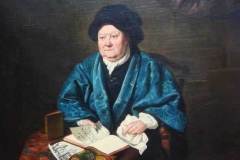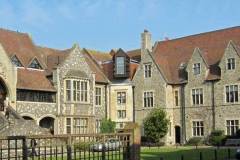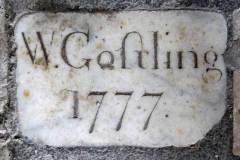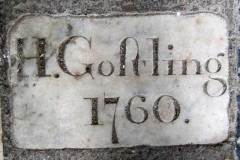(1696-1777) Clergyman, Antiquary, and Writer
Three pre-Victorian writers have left us invaluable detailed accounts of early Canterbury – William Somner (Antiquities of Canterbury), Edward Hasted (his 12 volume History and Topographical Survey of the County of Kent) and William Gostling’s Walk in and about the City of Canterbury. The last of these first appeared in 1774 and it provides an opinionated and readable account of the city at that time.
William Gostling was born in 1695, son of a successful clergyman and singer. His father, John Gostling, became a minor canon of Canterbury and sub-dean of St Paul’s, and was nationally renowned for the power and range of his bass singing voice. Henry Purcell is known to have written an anthem for him. William was baptized in Canterbury cathedral in early 1697 and became a King’s scholar at King’s School. He went on to graduate at St John’s College Cambridge, and married Hester Thomas at the cathedral in 1717. William often referred to her in affection as ‘his dragon’ – she bore him nine children despite (like her husband) suffering many years of serious gout. Ordained in 1721, William served as the incumbent in several local parishes including Brook, Littlebourne and Stone in Oxney. In 1727, at the age of 30, he became a minor canon in the Cathedral, a post he held for 50 years until his death in 1777. Throughout his life, William took a lively interest in the history of Canterbury, keeping notes and guiding groups around the city and cathedral. His gout struck when he was in his early fifties and grew steadily worse over the remaining 30 years of his life. It is striking that the assembling and drafting of the Walk in and about the city, which reads in places as a lively tourist guide book, was achieved during a period (in all over 20 years) when William was unable to leave his bedroom. The Dean and Chapter provided assistance for the publication, and funded an illustration of the cathedral screen. The book sold well, attaining the status of an official guide – William is holding a copy in the portrait which hangs today on the wall of the Cathedral Library. His walking stick, three feet long with an ivory knob and silver inlay, was acquired by the Canterbury Royal Museum.
Gostling also organised private musical events for the residents of the Cathedral Precincts, which were held at his house overlooking Green Court, now a part of the King’s School. His collection of music, which built on that of his father, is known to be extensive, as evidenced by an catalogue of the auction of his effects in May 1777, now in the British Library [Hirsch IV.1083], which contains 173 lots, sold over two days. The music includes works by Handel, Francesco Geminiani, Giovanni Battista Bononcini and Gottfried Finger, as well as music by Purcell, William Boyce, Maurice Greene and Canterbury’s local composer William Flackton.
The graves of both William and Hester Gostling can be found in the west pane of the great cloister of Canterbury Cathedral (images 3 and 4 below).
Sources: Oxford Dictionary of National Biography; Ford (1984); Kentish Gazette 8 March 1777; Smith (1837)
An electronic copy of Walk in and about the City of Canterbury can be seen free via Google books.
DL




